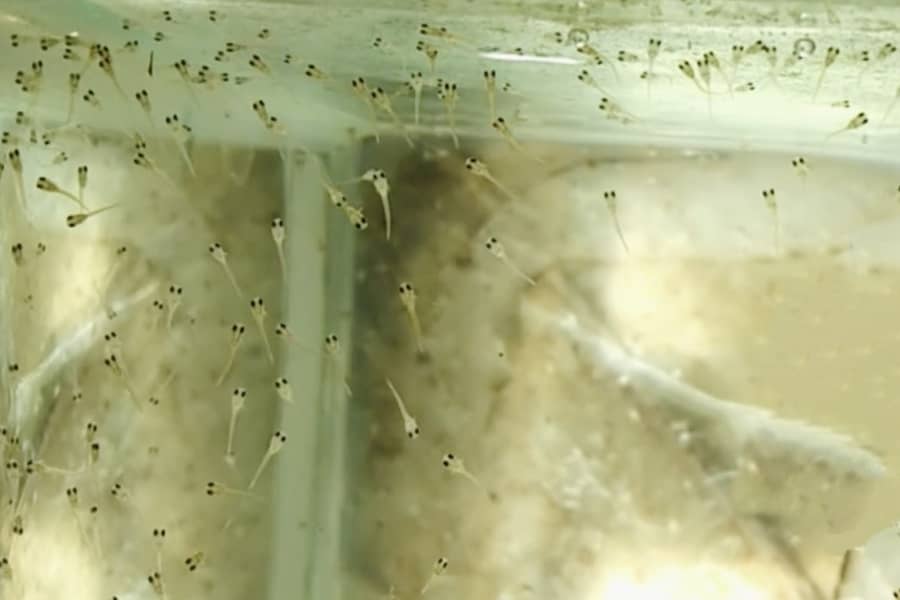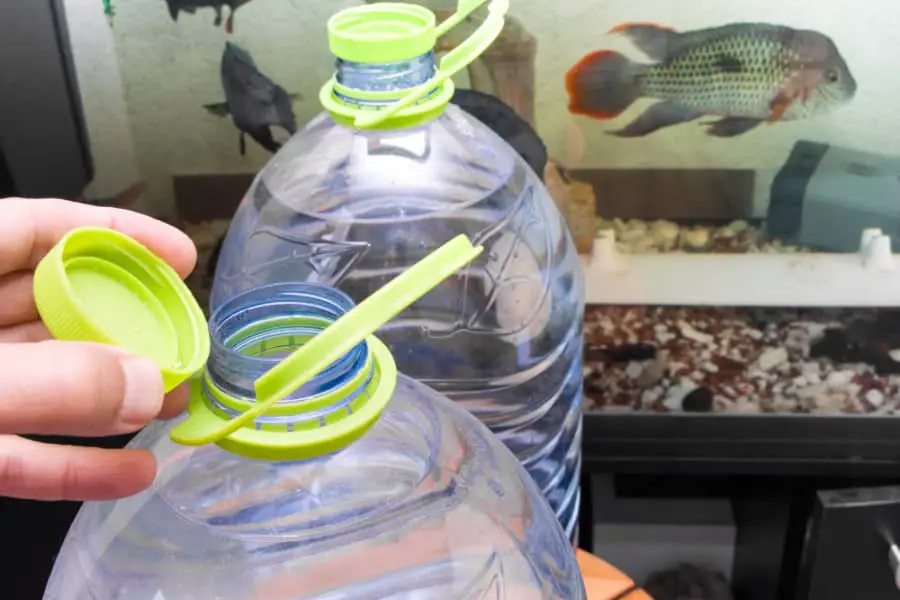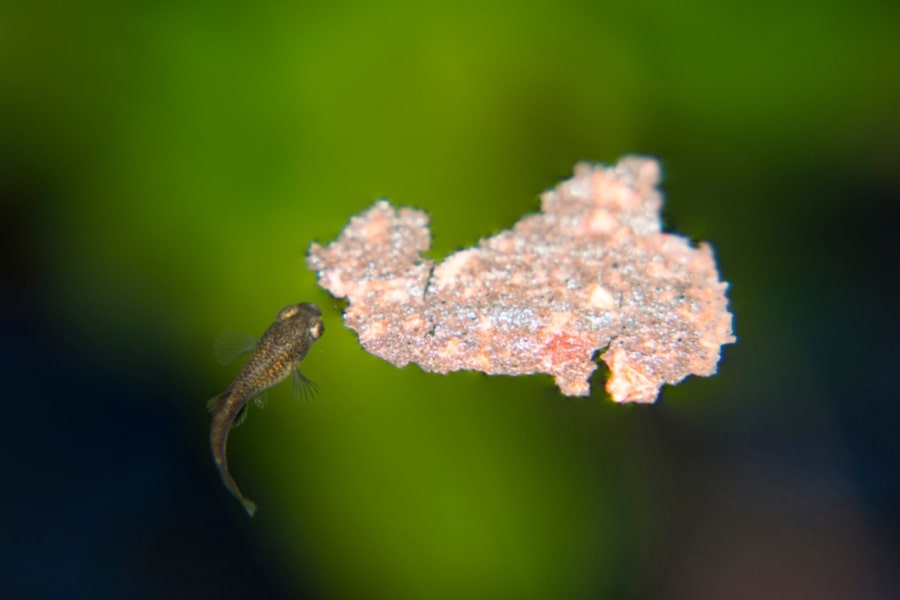How To Make Betta Fry Grow Faster: Here’s How

After hatching, betta fry usually takes three to five months to grow and reach full size. However, almost surprisingly, some professional betta breeders can produce fully developed, colorful bettas in just two to three months. How do they do that? Is there exist a magic pill to make betta fry grow quickly?
To make your Betta fry grow faster, transfer them to a grow-out tank, perform daily water changes and feed 4-5 meals daily (must include live food items.) For best results, maintain pH levels between 7.0-7.2 and a temperature of 85-88° F.
To know how to set up a grow-out fry tank and learn about the best foods to promote optimal growth in Betta fry, read the following sections.
How To Make Betta Fry Grow Faster?
To make Betta fry grow rapidly, you don’t have to do anything extraordinary. Accelerated growth rate simply requires you to provide Betta fry with optimum tank conditions and nutritious live food.
If you can maintain favourable water parameters and feed them regularly with appropriate amounts of high-protein food, your betta fry will grow faster and healthier.
Transfer the fry to a grow-out setup
A grow-out tank is a support aquarium designed specifically for raising fish fry. You can immediately transfer your betta fry into a grow-out tank or move them after three to four weeks of birth.
Depending on the size of the spawn, you can use a 10-20 gallon tank. Preferably, more space is better, but having a tank too big might cause difficulty in finding food, thus starving your baby fry to death.
A grow-out tank must be equipped with a fully functioning filtration system, preferably one that won’t suck the fry in. As you will need to feed the Betta fry frequently, a large amount of waste is expected. So to ensure optimum water conditions, a filter is a must-have.
Depending on your region, you may also need a heater to stabilise the aquarium temperature. Frequent fluctuations in water temperature are lethal for Betta fry.
For lighting, natural daylight is best, but if it’s not available, you can resort to an aquarium light. If possible, put some live plants in your grow-out tank. It helps provide infusoria, a natural food source for young fry.
Last but not the least, cover your tank with a lid to prevent the fry from jumping out.
Maintain favourable water conditions
Fish in a fry stage are most vulnerable to poor tank conditions. Even the slightest fluctuations in pH levels and temperature can result in chronic stress leading to death.
Maintaining the following water parameters will ensure a healthy tank environment for your betta fry and help accelerate their growth.
| Water temperature | 85-88° F (29-31° C) |
| pH Level | 7.0-7.2 |
| Water Hardness | 2-20 dGH (70-300 ppm) |
| Carbonate Hardness | 3-5 dKH (55- 90 ppm) |
| Ammonia | 0 ppm |
| Nitrites | 0 ppm |
| Nitrates | <20 ppm |
You can test these parameters using API Aquarium Test Kit.
Temperature is another crucial element betta fry are highly sensitive to. For optimal fry growth, you should maintain 85-88° F in your grow-out tank.
Nowadays, almost all aquarium heaters come with an inbuilt thermometer to help hobbyists keep track and maintain a stable temperature limit.
Perform frequent water changes

Carrying out routine water changes is one of the most effective ways to maintain pristine water in your grow-out tank. Ideally, you should perform 25% of the water change twice a week or replace a smaller amount of water each day.
Aquarium filtration supported by routinely water changes effectively removes the decaying organic material (leftover food, fish waste, and dead fry) from the tank and keeps ammonia poisoning at bay. Maintaining an optimum condition helps stimulate the rapid growth of the betta fry.
How to change the water for fry tanks without losing any fry?
There are different ways to remove dirty water from your grow-out tank. A simple ‘Youtube search’ will reveal a myriad of methods to choose from.
A caveat to mention, whichever method suits you, do not use a regular gravel siphon for this task. It risks sucking out and killing the tiny fry fish.
For the sake of this article and to showcase our readers how to safely remove water from the fry tank, we will require a miniature mop and a ketchup dispenser.
It’s an effective and easy-to-use tool that requires minimum effort to get the job done.
- Firstly, DIY a miniature mop if you don’t already have one. For how-do-to, look up videos on the internet.
- Using your mini mop, remove the dirt accumulated at the bottom and on the tank’s walls. Do it diligently, so you don’t kill any of your fry.
- After completing the mopping part, grab your ketchup dispenser and start sucking in the dirt.
- Discharge the dirty water in a separate container and repeat the vacuuming process until the tank looks detritus-free.
- Lastly, refill your grow-out with treated or aged water as required.
Reduce Growth Inhibiting Hormone (GIH)
Most fish, including Bettas, secretes potent hormones that stunt growth.
It’s often the larger fish in the tank that releases growth-inhibiting toxins to discourage rivalry. And as a result, these hormones restrict the growth of other smaller fish.
To ensure your betta fry’s growth isn’t stunted by GIH, perform daily water changes. When doing big water changes, more than 50%, make sure the treated water you are re-filling your tank with, has the pH levels and temperature similar to the grow-out tank.
Ever wondered why transferring fry to a grow-out tank encourages rapid growth? It’s simply due to the hormones-free, clean water tiny fry experiences, unlike in breeding tanks.
Provide Growth Promoting Food

It goes without saying that food is the most crucial element for the growth of fish fry.
Betta fry, likewise any other fish, tends to nip on anything that is moving and smaller than them. So initially, you should only feed live food to the baby fry for the first few weeks. Later on, you can start introducing frozen foods to their diet.
Some of the best live food that promotes optimal growth in betta fry include:
- Infusoria
- Tiny free-living nematodes such as Vinegar Eels, Microworms, Banana Worms, and Walter Worms
- Baby Brine Shrimp
- Daphnia
- Fairy Shrimp
- Grindal Worms
NOTE: Live food cultures aren’t always readily available in local fish stores, so make sure you have some arrangements in place.
When to start feeding Betta fry?
Newly hatched betta fry will remain in a bubble nest, clinging to it for the first few days.
As long as fry are attached in a cluster, they feed off their egg sacs. Once they break free from egg sacs and become free swimmers, you can start feeding them live food.
How often to feed Betta fry?
Professional breeders suggest feeding several small meals a day rather than a few large meals.
Typically, you can give 4-5 small feedings to your betta fry.
The number of feedings can be reduced as the fry start to grow older and larger. A tell-tale sign of a fish fry maturity is when they start feeding on dry food items.
There is a thin line between giving enough food to the fry (so they don’t starve and grow faster and healthier) and overfeeding the tiny creatures. Since it’s easy to fall on the latter side, make sure you know the limits.
Unless you’re carrying out daily water changes, remove the leftover food within 30 minutes of every feeding. Certain food can quickly contaminate the water, so it’s best to get rid of what isn’t consumed by the fry.
Fry-feeding guide for maximum growth
If you are wondering which food and in what order it should be served over the span of weeks, here is your betta fry step-by-step feeding guide:
- From the point of becoming free swimmers to the next three days, you should only feed minuscule foods to the betta fry. It includes infusoria and tiny free-living nematodes like vinegar eels, microworms, banana worms, and walter worms.
- After three days, you can start feeding baby brine shrimps.
- After a week, you can continue to feed baby brine shrimps. But stop giving nematodes as they will be less beneficial onwards (in terms of nutritional value.)
- In 3-4 weeks, you can introduce finely-grated frozen foods to your fry diet alongside brine shrimps. We recommend starting with frozen Bloodworms and frozen Daphnia. Bettas love variety in their food.
- After 4-5 weeks, you can start feeding aquatic worms such as Blackworms and Grindal Worms.
- Once reaching 8-9 weeks of their lifetime, Betta fry are mature enough to eat and digest almost any Betta food you offer them. It may include Bloodworms, frozen food items and dry foods such as flakes, pellets and sticks.
When To Separate Male Betta Fry?
As young males begin to grow, they become aggressive towards other tankmates, usually at the age of 9-1o weeks old. Therefore, it’s necessary to separate the male bettas as soon as you find them nipping on smaller fish.
The process of separating male fish fry is known as “jarring.” Each male requires to have his territory, which could be a jar, bottle, cup or other containers.
Female Bettas can also be moved in separate containers. However, if you don’t have enough space available, you can accommodate them together in a tank. But be aware that bigger fish will not spare the life of their smaller siblings.
Depending on how many jars you got to maintain, it may get quite difficult, especially if you aren’t an experienced breeder.
How Big Do Bettas Get?
Typically, adult Betta fish are between 2-3 inches long, with an average size of 2.5 inches.
Unlike species such as Goldish, Bettas do not grow throughout their life. Once they’ve reached the mark of three inches in length or turned six-seven months old, their growth takes a permanent halt.
Female Bettas usually display faster growth rates than male Bettas. However, in the end, once they have grown fully, females fall short in size.
Some Betta fish might look bigger than others due to their larger fins, and some just grow larger in bodily size.
Why Your Betta Fry Is Growing Slowly?
If your Betta fry are growing at an abnormally slower rate, then it’s something to be concerned about.
There can be numerous reasons hindering your fry growth, including the overabundance of Growth Inhibiting Hormones, poor water quality, lack of nutrition or a smaller tank.
We can’t tell what exactly the issue is with your fry tank. However, we can suggest some remedies that hopefully resolve the ‘seemingly unknown’ problem.
- Start with making big water changes, preferably daily.
- Test your water quality, and make sure the recommended parameters (shared above) for Betta fry are met.
- pH levels, temperature and ammonia levels are the most crucial of all that you should pay close attention to.
- Check your filter to see if it’s functioning correctly. If possible, install an oxygenation unit in the tank, such as an aerator or a bubbler.
Adhering to the above factors will take care of the water quality. Next, you have to take into account the type of food you are feeding Betta fry.
- If you aren’t already feeding your Betta fry 4-5 smaller meals a day, start it from today.
- Bettas are carnivorous so try to include more of the live food in their diet. Include as many varieties in the meal to have their nutritional requirement met.
Check out the fry-feeding guide we shared earlier in this article. Once you’ve figured out what’s missing in the diet equation, rectify it accordingly.
- Overstocked tanks are often stressful for the fry, which can invariably inhibit their growth. So make sure your Betta fry has enough space to swim freely.
- Lighting, whether natural daylight or artificial light, is necessary for raising fry.
It’s worth noting that some fry in your tank may have fallen victim to deformities. And therefore, they are having slower growth than an average Betta fry.
Betta Fry Growth Stages – From Fry To Adult
We were about to wrap up the article but then thought of adding this section.
Any hobbyist looking for ways to accelerate their Betta fry growth rate is likely to be interested in having a firm understanding of the growth stages.
NOTE: The time span (for growth) given below can vary based on how you raise your Betta fry. You can promote fast growth if you comply with the techniques shared in this article.
Stage 1: Laying Eggs
First, the mating process takes. In this stage, a male Betta will build bubble nests covered with mucus.
Once the female fish has successfully fertilized the eggs, she will spawn. The male will collect all eggs in the bubble nest and protect them for the further stage.
Stage 2: Hatching
It may take 24 to 48 hours for the eggs to hatch.
After coming out of the eggs, the fry will remain attached to the egg sacks for another 24 hours while feeding on the yolk.
Within a few days, you will witness the tiny fry leaving the nest and becoming free swimmers ready for their first minuscule food feedings.
Stage 3: Juvenile Fry
In this stage, after a few weeks, Betta fry will start developing their labyrinth organ and may also show some colors.
At the end of the juvenile stage, which usually lasts 2 to 3 weeks, you can expect your Betta fry to attain 0.6 inches to an inch in size.
Stage 4: Young Fry
By the time Betta fry reaches this stage, their fins start to grow faster. You will know they are close to maturity as they start displaying vibrant colours and shades.
A seven to ten weeks old Betta fry is considered young. But even at this point, they are not fertile to reproduce.
Stage 5: Adult Fish
When fish have attained their sexual maturity, they become adults and are not fry anymore.
By this time, a Betta fish should be fully grown – obtaining a length of 2-3 inches.
Related Questions
How long to Bettas live?
An average life span of a Betta fish in captivity is 2-4 years.
What age do Betta fry get colors?
By the time Bettas turn 8-9 weeks old, they start forming characteristic vivid colours. Your Betta fry may display colours early, depending on the diet and tank conditions.
How long does it take Betta fry to hatch?
The hatching time for the eggs depends on numerous factors. Typically, it can take 2-3 days for the Betta eggs to hatch.
How long can Betta fry live together?
You can keep Betta fry together in a tank until you notice signs of aggression, which is common among 8 to 9 weeks old fish.
When you see male fish chasing females and fighting with smaller fish, know it’s the time to separate them.
Do Betta fry need an aerator?
If you have a filter producing even a bare minimum of water agitation, you don’t necessarily need an aerator in your grow-out fry tank.
Final Words
In a nutshell, making Betta fry grow faster mainly requires daily water changes and several feedings per day, preferably live food.
All you have to do is, take care of water quality and feed nutritious food, and you will not have to worry about the growth rate of your Betta fry.
